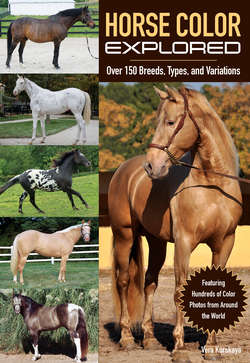Читать книгу Horse Economics - Vera Kurskaya - Страница 23
На сайте Литреса книга снята с продажи.
INHERITANCE OF BASE COLORS
ОглавлениеBase colors in horses (black, bay, seal brown, and chestnut) are controlled by two genes: Extension and Agouti. The gene corresponding to the Extension locus is called MC1R (melanocortin-1 receptor). The “Wild” allele of this gene, designated “E,” is dominant and codes for the intact, normal receptor for the melanocyte-stimulating hormone. Upon binding of the hormone, the receptor leads to the synthesis of the black pigment eumelanin in melanocytes.
A recessive allele of the receptor is designated “e,” and in the homozygous state the horse can produce only a defective receptor. As a result the melanocyte-stimulating hormone cannot activate the production of black pigment and the cells switch to synthesize the red/yellow pigment pheomelanin.
Thus, genotype “EE” or “Ee” determines the presence of black hair, and genotype “ee” produces red. A DNA test is available to test for the “e” (red factor) allele. With the aid of this test it is possible to determine if there is a chance to obtain foals with red color—for example, from a black horse. The absence of the “e” allele in the genotype (EE) means that a horse is homozygous for the dominant allele; the presence of allele “e” in a single copy (Ee) indicates that the horse is heterozygous. A horse homozygous for the recessive “e” allele (ee) can only have a chestnut base color.
The dominant allele “A” of the gene Agouti codes for an Agouti-signaling protein (ASIP), which is an antagonist of the melanocyte-stimulating hormone, neutralizing its action in some areas of the body. In these areas there isn’t any black pigment production and the hair is red. In sections in which Agouti-signaling protein is not produced (the mane, tail, lower part of the legs, and ear rims), the pigment synthesis is switched to the black eumelanin and the hair in these locations is black. Thus, dominant allele “A” leads to the formation of the bay color. The recessive allele “a” of Agouti results in the lack of production of ASIP, and in a homozygous state (aa) does not suppress the synthesis of black eumelanin throughout the entire integument. Therefore an “aa” horse, which also has the genotype “EE” or “Ee,” will have a black base color. A phenotype effect of the Agouti gene appears only in the presence of allele “E,” and directs the synthesis of eumelanin in necessary quantities. The Agouti gene has no effect in an “ee” homozygous horse because there is only the red pigment produced.
At present there is a DNA test for the “a” allele. It is possible to determine with this test, whether, for example a bay horse can produce a black foal. Interactions of the genes and alleles of Extension and Agouti are summarized below.
Table 1.
| Agouti | Extension | Color |
|---|---|---|
| AA, Aa | EE, Ee | Bay |
| aa | EE, Ee | Black |
| AA, Aa | ee | Chestnut (often) |
| aa | ee | Chestnut (rare) |
However there are additional alleles in these loci. An allele of Agouti designated “At” is responsible for the seal brown color and has an intermediate phenotypic effect between “A” and “a.” There is a hierarchy of domination (A > At > a), and a DNA test developed in 2009 helps breeders to distinguish the seal brown color from dark bay. Interactions of this allele with others in Agouti and Extension are summarized in the following table.
Table 2.
| Agouti | Extension | Color |
|---|---|---|
| AAt | EE, Ee | Bay |
| AtAt, Ata | EE, Ee | Seal Brown |
DNA tests show that the “At” allele is encountered much more frequently than it was thought previously. In the United States, Dr. Michal Prochazka (the translator of this text) detected this allele and developed the DNA test, but as of writing the information has not been published yet. Based on my research, “At” has been found in several breeds, including: the Thoroughbred, Quarter Horse, Paint Horse, Arabian, Morgan, American Miniature Horse, and in some British ponies. This allele was also found in six Przewalski horses.
The existence of another allele “A+” has been proposed, which is responsible for the “Wild” bay color. However, again as of writing, it has not been confirmed.
The Extension locus also has a third allele “ea,” which is recessive and present only in Black Forest Horses. In the homozygous state it leads to the formation of chestnut color—that is, phenotypically it is analogous to allele “e.” This can introduce confusion with the analysis of the red factor “e,” because a chestnut horse homozygous for the allele “ea” can be erroneously identified as homozygous for “E.” However, chestnut offspring will be produced upon crossing with another chestnut horse.
